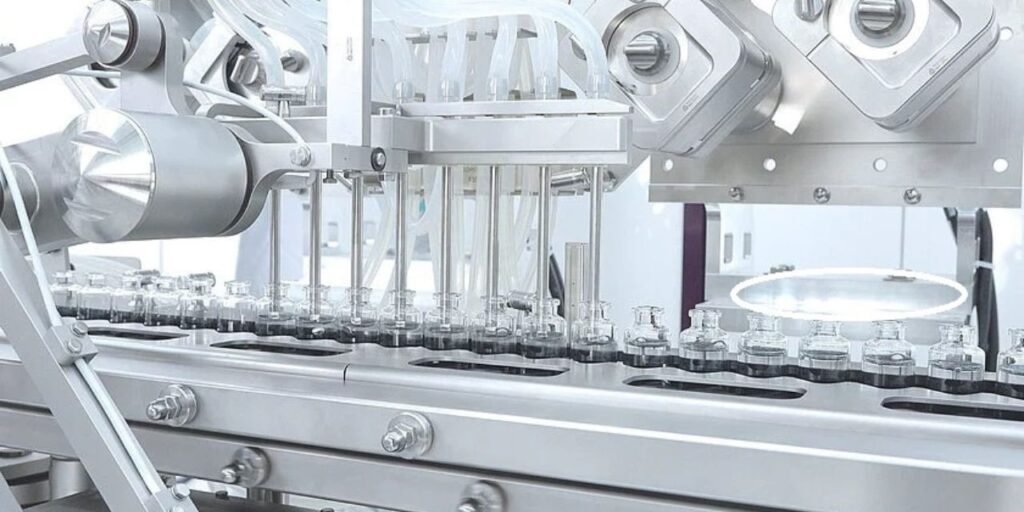
The market for robotic vial washing and filling devices has grown significantly on a global scale due to the growing use of automation in the biotechnology and pharmaceutical industries. The market is expected to grow at a compound annual growth rate, with a 2023 valuation of US$530.6 million.
a compound annual growth rate (CAGR) of 4.1% between 2024 and 2034, hitting US$ 816.6 million at the conclusion of the study period. The strong growth trend is a reflection of the rising need for sterile, accurate, and efficient solutions in pharmaceutical production processes.
Analysts’ Perspective on Market Expansion
The use of robotic vial washing and filling equipment has been further accelerated by the growing need for automation and accuracy in pharmaceutical manufacturing. These systems simplify important procedures that guarantee product quality, reduce human error, and improve operating efficiency, include cleaning, sterilising, and filling vials. They are essential to the biotechnology and pharmaceutical sectors due to their unmatched precision in handling delicate materials like vaccines and biologics.
Leading companies in the industry are progressively incorporating cutting-edge technology into robotic systems, including machine learning (ML) and artificial intelligence (AI). Real-time monitoring, predictive maintenance, and enhanced cleaning procedures to guarantee sterility have all been made possible by these developments.
when it is being produced. It is anticipated that this focus on technical innovation will continue to be a significant factor in market expansion, meeting the strict quality standards and legal requirements in the pharmaceutical industry.
Introduction to the Market
Advanced devices called robotic vial washing and filling machines are made to automatically clean, sterilise, and fill vials containing liquid drugs or other pharmaceutical materials. These devices minimise contamination hazards and increase manufacturing efficiency by upholding high accuracy and sterility. They are extensively used in the manufacturing of biologics, vaccines, and other delicate pharmaceutical items, where exact adherence to hygienic and quality requirements is essential.
Local Perspectives
- North America: Thanks to the existence of sophisticated pharmaceutical production facilities and growing pharmaceutical sales, the North American market contributes significantly to worldwide revenue.expenditures on automation. Because of its strict regulations and focus on upholding high standards in medication manufacture, the United States in particular is a prominent market.
- Europe: Another significant area, Europe is distinguished by the presence of powerful pharmaceutical companies and strict
- Asia Pacific: Over the course of the projection period, the Asia Pacific region is anticipated to develop at the quickest rate. The pharmaceutical industry’s explosive growth, together with rising expenditures in automation and infrastructural development in nations like China andIndia is propelling market expansion.
- Latin America: The region’s steady expansion may be ascribed to the growing demand for premium pharmaceutical items as well as the growing use of automation technology. The two largest markets in the area are Mexico and Brazil.
- Middle East & Africa: The Middle East & Africa region is gradually adopting robotic vial washing and filling machines, supported by growing healthcare investments and the establishment of pharmaceutical manufacturing facilities.
Market Drivers
- Growing requirement for Automation: The requirement for robotic systems has increased due to the pharmaceutical manufacturing industry’s increasing demands for sterility, accuracy, and efficiency.
- Emphasis on Reducing Human Error: Automation ensures consistent product quality by reducing the hazards associated with manual handling.
- Tight Regulations: Adherence to stringent pharmaceutical standards mandates the employment of sophisticated technologies that can satisfy sterility and cleanliness requirements.
- Growing Vaccine and Biologics manufacturing: The need for high-precision vial washing and filling equipment is driven by the growing emphasis on vaccine and biologics manufacturing.
Important Technological Developments
AI and ML Integration: Cutting-edge robotic systems with AI and ML improve operational efficiency by enabling predictive maintenance and real-time monitoring.
Better Cleaning Procedures: Better cleaning systems guarantee sterility and lower the danger of infection.
Customisable Solutions: To accommodate various pharmaceutical processes, manufacturers are providing systems that are specifically designed to satisfy customer needs.
Prospects for the Future
The market for robotic vial cleaning and filling machines is expected to increase steadily due to the pharmaceutical industry’s expansion and ongoing technological improvements. As automation
becomes essential to the production of pharmaceuticals, the use of these systems is anticipated to increase dramatically. Key businesses are concentrating on innovation and strategic alliances to increase their market presence in order to take advantage of this growth. Furthermore, as pharmaceutical businesses in Asia Pacific and Latin America increasingly use automated solutions to fulfil international quality standards, these expanding markets provide significant potential.
In conclusion, By providing sterile, accurate, and efficient solutions, the global market for robotic vial washing and filling machines is poised to revolutionise pharmaceutical production. The industry is well-positioned to satisfy these demands thanks to rising expenditures in automation and technical improvements. the changing demands of the biotechnology and pharmaceutical industries, guaranteeing globally compliant and high-quality medication manufacture.
